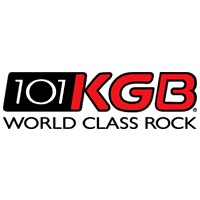HAAT 152 meters City of license San Diego Area San Diego | First air date 1950 (as KSON-FM) Frequency 101.5 MHz Branding 101-5 KGB | |
 | ||
Slogan San Diego's World Class Rock | ||
KGB-FM (101.5 FM) is a classic rock radio station in San Diego, California. It is owned and operated by iHeartMedia, Inc.. The station's studios are located in San Diego's Kearny Mesa neighborhood on the northeast side, and the transmitter is located in East San Diego east of Balboa Park.
Contents
History
See KLSD#History for the history of the letters 'KGB' used as a radio station name.The 101.5 MHz FM frequency originally signed on the air in 1950 as KSON-FM, owned by Fred Rabel. 101.5 is the second oldest FM station in San Diego (94.1 formerly KFSD-FM signed on in 1948). Rabel later sold the signal to Brown Broadcasting in 1958. 101.5 was moved off the KSON AM tower on the corner of Highway 15 and Interstate 5, to the new site of KGB/1360 at 52nd Street and Kalmia. 101.5's call letters were changed to KGB-FM. In 1964 Brown Broadcasting hired Bill Drake to consult for 136KGB and it later became Boss Radio. In 1964 the AM and the FM were separated, and 101.5 became KBKB, a beautiful music station.
In 1972 Boss Radio on 1360 KGB was failing, and more focus was being given to the FM. Brown Broadcasting hired Ron Jacobs to turn around 101.5. The first thing that he did was to put the KGB-FM call letters back on 101.5, and drop Boss Radio from 1360 AM. Jacobs created San Diego's first "Album Oriented Rock" (AOR) station. KGB-FM was a ground breaking station due to the leadership of Jacobs and General Manager Sonny Jim Price. The KGB Chicken, The Homegrown Albums, and Skyshow were just a few of the groundbreaking events that were created during this era of KGB-FM
KGB-FM was named "Station of the Year" by Billboard in 1974 and Rock Station of the Year by Rolling Stone magazine in 1991.
KGB-FM created most of the radio and television legends that San Diego knows today including; Larry Himmel (the Cruiser), Bob Coburn, Dave Benson, Damian Bragdon, Gabriel Wisdom, Erik Thompson, Jim McInnes, Rick Leibert, Pat Martin, Larry Bruce, Bill Hergonson, Ernesto Gladden, Ted Edwards, Linda McInnes, Digby Welch, Kevin McKeown, Pam Edwards, Brian Schock, Susan Hemphill, John Leslie, Andy Geller, Blair and Kymythy Schultz, Phil Hendrie, Jeff Prescott, Michael Berger, Sue Delany, Cookie "Chainsaw" Randolph, Dave Rickards, Shelly Dunn, Coe Lewis and Mojo Nixon.
News anchors during this period included Brad Messer, Brent Seltzer, Gerry Gazlay and George Wilson.
Notable promotions
In 1974, KGB gave the world a piece of pop culture Americana. The "KGB Chicken," an advertising mascot played by Ted Giannoulas, was hatched that year when employees of KGB-FM hired Giannoulas (then a student at San Diego State University) from off the street to wear a chicken outfit for a promotion to distribute AM and FM Easter eggs to children at the San Diego Wild Animal Park. The Chicken, whose antics entertained steadily larger crowds, moved on to features at concerts and sporting events (appearing at more than 520 San Diego Padres games in a row). Conflict emerged between KGB Radio and Giannoulas, and the latter was fired in 1977. Another unnamed employee was hired to don a chicken outfit at a Padres game. After a lawsuit was decided in Giannoulas's favor in June 1979, Giannoulas was allowed to continue to perform in a chicken costume (though not the same as the original costume), and his San Diego Chicken emerged from his egg at a "Grand Hatching" seen by 47,000 people as the theme from 2001: A Space Odyssey played.
In 1973, KGB created an annual contest called "Homegrown," in which local singers and songwriters submitted songs about the San Diego area for inclusion on an album produced by the station. Proceeds from sale of the albums went to local charities. The contest ran through 1978, yielding seven albums named Homegrown through Homegrown 7, with copyrights from 1973 to 1979. There were two additional Homegrown albums. One was Homegrown's "Greatest Hits" in 1978 with favorites from previous albums. The other was Homegrown, "Songs for 84" with additional songs by San Diego artists about San Diego. In 1976, singer Stephen Bishop submitted his song, "On and On," but it was rejected because he submitted it on cassette tape instead of the required reel-to-reel format. The song went on to become a commercial hit.
In 1976, KGB-FM launched the SKY SHOW and it has continued for 40 consecutive years. (Sky Show 40 was on September 5, 2015) The Sky Show is a fireworks display, synchronized to a music soundtrack, broadcast on the radio. An artform invented by KGB and now practiced worldwide. The first SKY SHOW was fired from two locations, Fiesta Island and Chollas Lake. It created traffic jams all over the city as people watched and listened. The firing site was moved to San Diego (Jack Murphy)(Qualcomm) Stadium for reasons of crowd control. The show has become a very well attended annual event with fans viewing from both inside the stadium and outside, tailgating in the parking lot or from vantage points along Mission Valley's canyon rim. The KGB SKY SHOW also introduced the use of Rock and Roll music, multi-media, video, theatrical lighting and effects to enhance the fireworks display. It is, according to its creator Rick Leibert, a "continuing experiment blending the ancient art of fireworks with rock and roll." The Creative team for KGB SKY SHOW has been collaborating for more than 20 years. Blair Schultze has been Writer/Producer/Director of KGB SKY SHOW since 1988, and Ron Dixon has been Fireworks coordinator since 1979 and Choreographer since 1990.
KGB-FM also airs 'The Beatles Radio Show', hosted by Ken Dashow, on Sundays..
